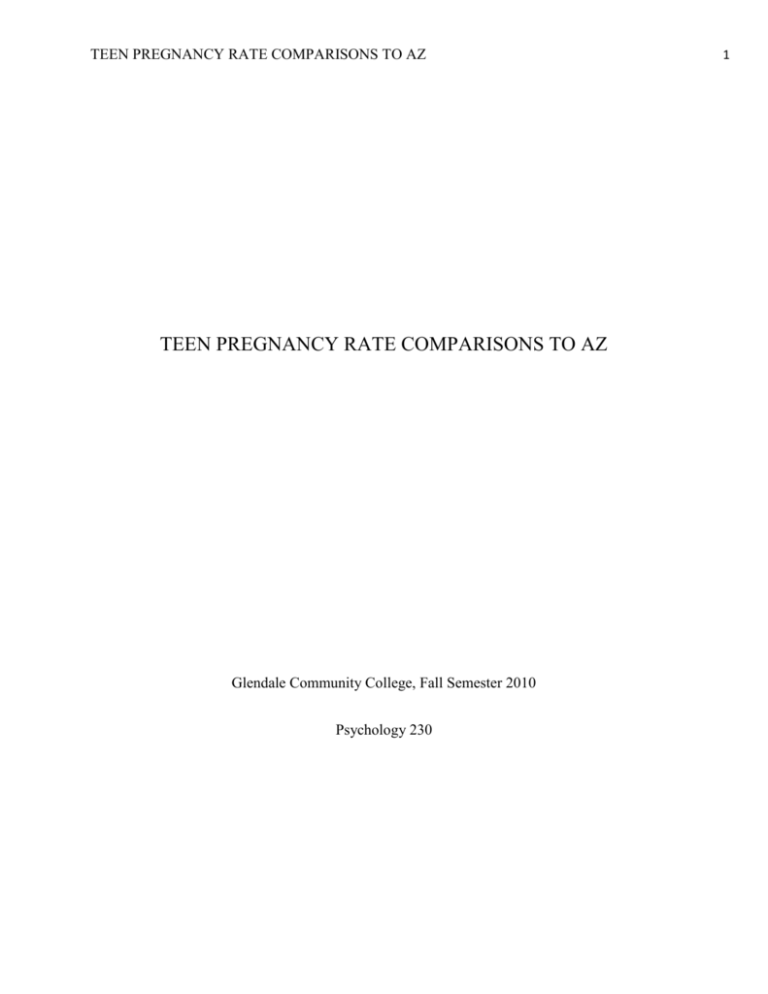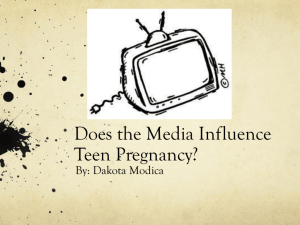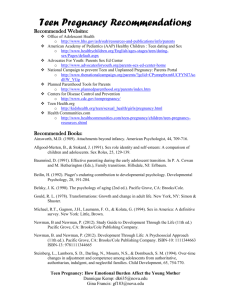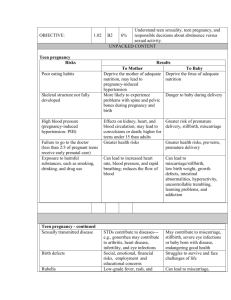TEEN PREGNANCY RATE COMPARISONS TO AZ TEEN
advertisement

TEEN PREGNANCY RATE COMPARISONS TO AZ TEEN PREGNANCY RATE COMPARISONS TO AZ Glendale Community College, Fall Semester 2010 Psychology 230 1 TEEN PREGNANCY RATE COMPARISONS TO AZ In the United States many teens are becoming pregnant during their adolescent years; the rate of teen pregnancy is commonly defined as the count of adolescent females who delivered a live infant, had an induced termination of pregnancy, or delivered a fetal death by the total number of adolescent females in a population during a given year (ADHS, 2009). Teen pregnancy has been a heavily studied topic of recent years, and the results have proven some alarming facts. Nearly one-half (46%) of all 15 to 19-year-olds in the United States have had sex at least once (Abma, 2004). A sexually active teen that does not use contraceptives has a 90% chance of becoming pregnant within one year (Harlap, 1991). Studies have found that each year, in the United States alone, almost 750,000 women between the ages of 15 and 19 become pregnant. Overall, 71.5 pregnancies per 1,000 women aged 15-19 occurred in 2006; the rate declined 41% from its peak in 1990 to a low of 69.5 in 2005 (Guttmacher, 2010). Eighty-two percent of teen pregnancies are unplanned; they account for about one-fifth of all unintended pregnancies annually (Finer, 2006). In 2008, the rate of teen pregnancy in Arizona was 31.6 pregnancies per 1,000 females age 19 years and younger (ADHS, 2009). Since 1999 the teen pregnancy rate, in Arizona, for 15-19 year old teens has declined 26 percent; 85.7 to 63.2 pregnancies per 1,000 females (ADHS, 2009). Declining teen birth rates have significantly improved overall child well-being in Arizona, all states, and the District of Columbia, according to a new state-by-state analysis released by the National Campaign to Prevent Teen Pregnancy (Albert, 2005). Specifically, declines in the teen birth rate have played a major role in improving child poverty in Arizona (Albert, 2005). The purpose of this study is to determine how the teen pregnancy rate in Arizona compares to the United States average, utilizing the most current data and research. I hypothesize that Arizona is significantly different in teen pregnancy rates when compared to the teen pregnancy rate in the other forty-nine states. 2 3 TEEN PREGNANCY RATE COMPARISONS TO AZ The source of my data is the Online Version of the 50-State and National Comparisons of Teen Pregnancy Rate from The National Campaign, which was last updated Jan. 2010. The Zscores were calculated for the number of teen pregnancies per 1,000 teens for each state. The data was analyzed using both Microsoft Excel and SPSS. The alpha is .05 with a critical value of +1.96 and -1.96. The mean teen pregnancy rate in the United States (all 50 states) is 64.6 pregnancies per 1,000 teens with a standard deviation of 14.1464 (14.14637763). The descriptive statistics for teen pregnancy rates are listed in Table 1 and Table 2. In Figure 1, the distribution is shows that teen pregnancy in the United States is negatively skewed. Table 3 is showing the number of teen pregnancies per every one-thousand teen girls and the z-scores for all fifty states in the US. My analysis shows that the Arizona teen pregnancy rate is not significantly different than the average pregnancy rate among other states in the US, however Arizona falls within the top 3 states of having the highest teen pregnancy rate, with a z-score of z = 1.72, p > 0.5. Table 1: Descriptive Statistics N Minimum Maximum Mean Std. Deviation Statistic Statistic Statistic Statistic Statistic TeenPregnancyRate 50 Valid N (listwise) 50 33 93 64.60 14.290 Skewness Statistic .016 Std. Error .337 TEEN PREGNANCY RATE COMPARISONS TO AZ Table 2: Statistics TeenPregnancyRate N Valid Missing 50 0 Mean 64.60 Std. Error of Mean 2.021 Median 62.50 Mode Std. Deviation 62 14.290 Skewness .016 Std. Error of Skewness .337 Minimum 33 Maximum 93 Sum Figure 1 3230 4 5 TEEN PREGNANCY RATE COMPARISONS TO AZ STATE Alabama Alaska Arizona Arkansas California Colorado Connecticut Delaware Florida Georgia Hawaii Idaho Illinois Indiana Iowa Kansas Kentucky Louisiana Maine Maryland Massachusetts Michigan Minnesota Mississippi Missouri Teen Pregnancy Rate 73 61 89 80 75 69 57 83 77 80 71 55 67 62 51 60 66 70 43 65 49 60 43 85 63 z-score 0.593791585 -0.25448211 1.724823177 1.088617906 0.735170534 0.311033688 -0.53724001 1.30068633 0.876549483 1.088617906 0.452412636 -0.67861895 0.169654739 -0.18379263 -0.96137685 -0.32517158 0.098965264 0.381723162 -1.52689265 0.02827579 -1.1027558 -0.32517158 -1.52689265 1.442065279 -0.11310316 STATE Montana Nebraska Nevada New Hampshire New Jersey New Mexico New York North Carolina North Dakota Ohio Oklahoma Oregon Pennsylvania Rhoda Island South Carolina South Dakota Tennessee Texas Utah Vermont Virginia Washington West Virginia Wisconsin Wyoming MEAN Population SD N Teen Pregnancy Rate 56 50 90 33 68 93 77 76 45 62 76 57 53 62 79 51 79 88 47 40 61 59 62 47 65 64.6 14.14637763 50 z-score -0.60792948 -1.032066327 1.795512651 -2.233787393 0.240344213 2.007581074 0.876549483 0.805860009 -1.385513699 -0.183792634 0.805860009 -0.537240006 -0.819997904 -0.183792634 1.017928432 -0.961376852 1.017928432 1.654133702 -1.24413475 -1.738961071 -0.254482108 -0.395861057 -0.183792634 -1.24413475 0.02827579 ** = over the mean, significant finding ~~ = below the mean, significant finding Table 3. Teen Pregnancy rate by state, compared to every 1,000 teens, source from Kost, 2010 ~~ ** TEEN PREGNANCY RATE COMPARISONS TO AZ The analysis of the statistics does not support my hypothesis; the teen pregnancy rates are not significantly different in Arizona in comparison to the rest of the United States. There are two states that are p < .05; New Mexico is significantly higher than the mean with a z-score of 2.0076, and New Hampshire was significantly lower than the mean with a z-score of -2.2338. This data reveals that although Arizona does not show a significant difference among the average teen pregnancy rates in the United States, it does show that Arizona is one of the top 3 states of having the highest overall teen pregnancy rate. Analyzing the teen pregnancy rate across the United States, the southern states have the highest overall pregnancy rates, while the northeastern states have the lowest overall pregnancy rates. The geographical locations may be something to continue future research with to identify more specific causes as to why there is a difference between the southern and northern states teen pregnancy rates. This study was a simplistic-study on the basis of looking at the teen pregnancy rates in every state; I did not consider race, ethnicity, geographical locations in the US, rich vs. poor, or educated vs. noneducated. The data results may vary when considering different populations and situations. As stated previously, declining teen pregnancy rates and birth rates contribute to improvements in child well-being in Arizona (and the US); specifically, declines in pregnancy rates have played a major role in improving child poverty in Arizona (Albert, 2005). With continued focus on the awareness and prevention on teen pregnancy, our future may continue to see more declines in the teen pregnancy rates. 6 TEEN PREGNANCY RATE COMPARISONS TO AZ References Abma JC et al., Teenagers in the United States: sexual activity, contraceptive use, and childbearing, 2002, Vital and Health Statistics, 2004, series 23, No. 24 http://womensissues.about.com/gi/o.htm?zi=1/XJ&zTi=1&sdn=womensissues&cdn=new sissues&tm=8&gps=238_344_1111_855&f=00&tt=3&bt=1&bts=0&st=14&zu=http%3 A//www.guttmacher.org/pubs/fb_ATSRH.html%23n25 Albert, B. (2005). The National Campaign to Prevent Teen Pregnancy. Declining Teen Birth Rates Contribute to Improvements in Child Well-Being in Arizona. Retrieved from http://www.thenationalcampaign.org/national.../Arizona_press_release_FINAL.pdf Arizona Department of Health Services. (2009). Teen Pregnancy in Arizona [Data file]. Retrieved from http://www.azdhs.gov/404.htm Finer LB et al., Disparities in rates of unintended pregnancy in the United States, 1994 and 2001, Perspectives on Sexual and Reproductive Health, 2006, 38 (2): 90-96 http://womensissues.about.com/gi/o.htm?zi=1/XJ&zTi=1&sdn=womensissues&cdn=new sissues&tm=8&gps=238_344_1111_855&f=00&tt=3&bt=1&bts=0&st=14&zu=http%3 A//www.guttmacher.org/pubs/fb_ATSRH.html%23n25 Guttmacher Institute, U.S. Teenage Pregnancies, Births and Abortions: National and State Trends and Trends by Race and Ethnicity, accessed Nov. 2010 http://womensissues.about.com/gi/o.htm?zi=1/XJ&zTi=1&sdn=womensissues&cdn=new sissues&tm=8&gps=238_344_1111_855&f=00&tt=3&bt=1&bts=0&st=14&zu=http%3 A//www.guttmacher.org/pubs/fb_ATSRH.html%23n25 7 TEEN PREGNANCY RATE COMPARISONS TO AZ References Harlap S, Kost K and Forrest JD, Preventing Pregnancy, Protecting Health: A New Look at Birth Control Choices in the United States, New York: AGl, 1991. http://womensissues.about.com/gi/o.htm?zi=1/XJ&zTi=1&sdn=womensissues&cdn=new sissues&tm=8&gps=238_344_1111_855&f=00&tt=3&bt=1&bts=0&st=14&zu=http%3 A//www.guttmacher.org/pubs/fb_ATSRH.html%23n25 Kost, K., Henshaw, S., & Carlin, L. (2010). U.S. Teenage Pregnancies, Births and Abortions: National and State Trends and Trends by Race and Ethnicity, 50-State and National Comparisons. Retrieved from http://www.thenationalcampaign.org/state-data/statecomparisions.asp?id=3&sID=18 8




